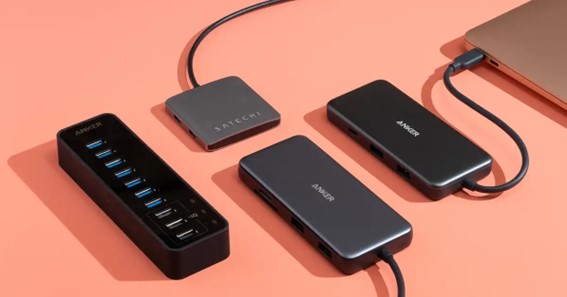Do you know the speed of USB 1.0? If not, then read this article till the end. In this article, we will give you a simple and very basic way to calculate USB 1.0 speed. USB 1.0 is also called the first generation of USB, 1.0 is used to show it is a first-generation USB. It was released in 1995 and is capable of transferring data. The full form of the USB is the Universal Serial Bus, which is a technology used to connect computers with peripheral devices, and also to transfer data from one device to another. It is simply a cable with some industrial standards. Let’s get started and know the speed of USB 1.0.
What Is The Speed Of USB 1.0?
The speed of USB 1.0 is between 1.5 megabits per second and 12 megabits per second. When connecting devices with different USB versions, the transfer rate is limited to the slowest connected device. This means that data transfer will occur at 12 Mbps when you connect a USB 2.0 device to a USB 1.1 device, even though the USB 2.0 device is capable of transferring data at 480 Mbps. here are the different speeds of the USB generation one,
Click here – What Is The Speed Of Go Karts?
- The max speed of USB 1.0 is 12 megabits per second
- The top speed of USB 1.0 is 12 megabits per second
- The maximum speed of USB 1.0 is 12 megabits per second
- The USB 1.0 Max speed is 12 megabits per second
- The max transfer speed of USB 1.0 is 12 megabits per second
Now, you know what is max speed of USB 1.0. Let’s learn how to calculate the speed of the USB first generation.
Calculate The Speed Of USB 1.0
To calculate the speed of the USB 1.0, you don’t need a mathematical formula. For that, you need to know a command. Here we have given a command to check the USB 1.0 speed,
Command: 1susb -t
Well, after giving this command you will get an output that like this on the Roadrunner SOM,
Output:
/: Bus 02.Port 1: Dev 1, Class=root_hub, Driver=at91_ohci/3p, 12M
/: Bus 01.Port 1: Dev 1, Class=root_hub, Driver=atmel-ehci/3p, 480M
That means that inside the Microchip SAMA5D27 MPU exists an Open Host Controller Interface (OHCI) that supports the USB 1.0 standard and an Enhanced Host Controller Interface (EHCI) that supports the USB 2.0 standard.
About USB 1.0
The USB means Universal Serial Bus, which is a cable with industrial standard mainly used to connect the peripheral devices to the computer to transfer data. By using USB you can also transfer power, files, and videos. Early in 1996, the USB 1.0 was issued as the first major release in the USB line. It has given the data transfer rates of 15 Mbps at low speed and 12 Mbps at full speed. It was also self-configuring, eliminating user changes to device setting to accommodate peripherals.
The interface was also hot-swappable, so devices could be changed without rebooting the host computer, even though it was the first commercial version of the USB, it wasn’t widely accepted by the market and few devices were available to consumers. The USB modification didn’t stop at generation one but it continued and formed USB 1.1, USB 2.0 generations.
Assemble more facts on different topics like these on Countspeed
FAQ
Can A USB 1.0 Be Used In A 2.0 Port?
Yes, USB 1.0 or 1.1 devices and hubs are compatible with USB 2.0. However, a USB 1.0 or 1.1 devices will not have all of the capabilities and features found USB 2.0.
Can USB 1.0 Can Transmit Data At 12 Megabits Per Second?
Brief History Of The Universal Serial Bus
Although by today’s standards, a maximum transfer rate of 1.5 Mbps (USB 1.0) and 12 Mbps (USB 1.1) is nearly unfathomable, back then, these standards set the bar.
Can A USB 3.0 Be Used In A 1.0 Port?
Yes it will, USB has always been designed with backwards compatibility in mind so even though USB 3.0 connector is different from the 1.0 and 2.0 connectors, it will still work with them. You simply will not be able to benefit from the speed 3.0 was designed to produce.
Click here – What Is The Speed Of Aircrafts?
What Is USB 1.0 Used For?
The first generation of USB (1.0) was released in 1995 and capable of transferring data at 1.5 Mbps, which ran mouses, keyboards and gamepads. The updated version, USB 1.1, increased that speed to up to 12 Mbps. USB 2.0, the second generation, was introduced in 2000 and capable of data transfer speeds up to 480 Mbps.
Is USB 1.0 Slow?
USB 1.0 and 1.1
USB 1.0 marked the first major release of the USB standards in 1996, offering data transfer rates of 1.5 megabits per second (Mbps) at low speed and 12 Mbps at full speed.
Conclusion
After reading this article, you understood how fast is USB 1.0 transfer data from one device to another device. The first generation USB cable capable of transferring data at 1.5 megabits per second, which can run mouses, keyboards, and gamepads. The updated version of the USB increased that speed to up to 12 megabits per second. The USB 2.0 generation, called the second generation, was introduced in 2000 and capable of data transfer speed of USB 1.0 is up to 480 Megabits per second.
What is 1.0 a USB
What was USB 1.0?
